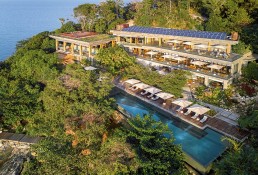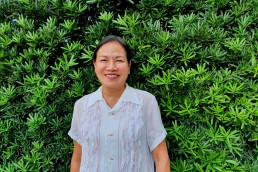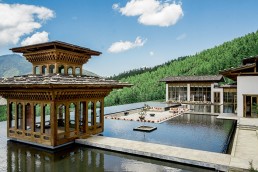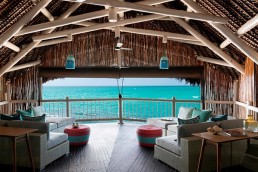REVIEW: Six Senses Krabey Island
A new player in the Cambodian Riviera plays gentle host to its idyllic island locale.
Approaching Krabey Island by speedboat, it’s hard to make out any signs of manmade intervention. A bulbous crop of forested land peeking above the still canvas of ocean, it is only on nearing the jetty of Six Senses Krabey Island that a rectilinear volume of dark basalt stone and golden local koki timber provides the prelude to a subtle, well-conceived architectural scheme unifying itself with the locale’s tones and textures.
Six Senses Krabey Island is situated in Cambodia’s Koh Rong archipelago, reached via a ten-minute car ride from Sihanouk International Airport and a brief boat commute from a private jetty on the Ream mainland. This route sidesteps the now dishevelled casino- and construction-laden Sihanoukville main town – the antithesis of the resort’s calm. The arrival of Six Senses represents renewed interest in this beauteous region, touted as Cambodia’s ‘French Riviera’, whose potential was stunted by years of strife and under-developed infrastructure.
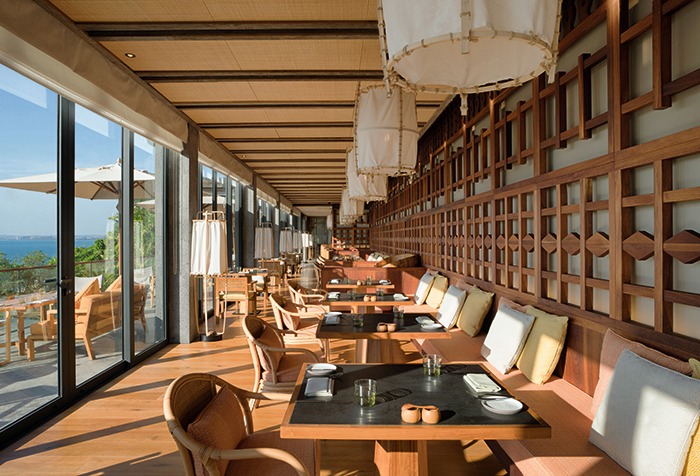
The newcomer undoubtedly sets the bar high, with sophisticated design and modern comforts rooted strongly in context. 40 villas and an array of public amenities dot the island, and the need to buggy around allows guests an understanding of the rugged terrain while taking in local inhabitants that include hornbills, butterflies and monkeys. The architecture of the villas parallels the jetty’s arrival block, with a subdued material palette receding the boxy forms into the shadows of the jungle, describes Olga Pavlytchenko, Project Assistant at RPB Investment Co., which owns the property and conceived its architecture.
Floor-to-ceiling glazing offers generous indoor-outdoor encounters, while the slate-decked private pool steps down from the villa following the natural relief. Interiors are accented with textural and cultural narratives. “The design responds to Six Senses’ core values of being sensitive to locality, providing guests with unique and crafted experiences of quirkiness and fun,” comments Bangkok-based interior design firm Dimensional Interpretation Studio (DIN Studio).
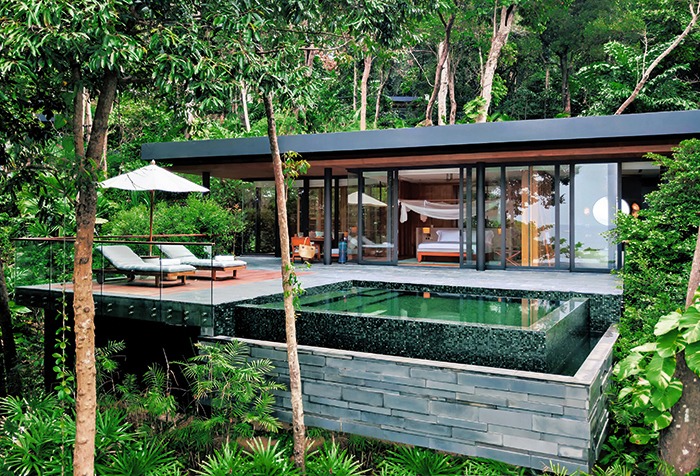
Timber wall panelling incorporating functional components such as doors reference elements of traditional Cambodian houses, and turquoise shades in the furnishings mirror the scenery. The fluid lines of the Romdoul – Cambodia’s national flower that is native to the island – are carved onto lighting fixtures, bathrobe hooks and furniture legs, and unites with the water buffalo (Krabey means buffalo in the Khmer language) in an elegiac wall panel artwork by Thai artist Korakot Aromdee.
This spatial storytelling continues at the main facility building, representing a fisherman’s house writ large. The lobby lounge decked with sofa partitions and wind-swung pendants woven from bamboo alludes to the space where fishing nets are aired. Some steps down, the open-air Sunset Bar exudes the ambiance of a veranda, where fishermen and their families would socialise and make or repair nets. Here, the imagery becomes literal, with an installation of fish swimming overhead and trap-like decorative lighting. Within the streamlined shell, these intricate experiments of pattern and form lend a human touch.
Down another tier, the AHA Restaurant invites guests to dine on Pan-Asian cuisine made from local produce in the inner sanctums of the fisherman’s house. Traditional balustrade patterns become wall features, ceilings are adorned with checked Khmer Krama scarf fabrics and lighting fixtures are wrapped in sheer fabric like mosquito nets on bedframes.

At the building’s base, the ice-cream parlour is punctuated with shelves, whose vertically exaggerated supports evoke the underside of the fisherman’s stilted house.
Elsewhere on the island, Tree Restaurant is enveloped in foliage and guests indulge in modern interpretations of Khmer-inspired cuisine under Aromdee’s bamboo honeycomb ceiling panels accented with teardrop-shaped lights that recall weaverbirds’ nests. “The restaurant is small but we amplified its visual dimension by lighting the outside forest to equal the brightness of the interior and letting the light gradient toward the sea,” describes Bangkok-based consultancy’s Managing Director Tippaya Prasertsuk on the energy-efficient yet poetically attuned lighting scheme.
The tale of the Khmer people’s relationship with water – commonly used in rituals and cleansing ceremonies – is told at the 2,000m2 spa. Interlocking indoor and outdoor spaces are finished with stacked lava stone reminiscent of the ancient Angkor Wat. “The idea was to mitigate a large complex with smaller volumes that picturesquely ‘grow’ into the landscape,” comments Pavlychenko. Inside, DIN Studio’s scheme sees undulating timber ceilings that replicate water ripples, walls coloured in the local indigo dye and timber structures representing abstract air bubbles.
While many hotels trumpet sustainability as a trend, Six Senses Krabey Island’s efforts are real. Aside from the prevalent use of sustainable materials, rooftops are camouflaged with landscaping to cool interiors and solar panels on the facility building will ideally generate 10% of the resort’s power by 2020. Resort programmes offer trips to the Earth Lab Sustainability Hub and organic garden on the mainland, where one learns that a crystal water refinery produces the resort’s drinking water, which are packed into recyclable glass bottles. Fruits and vegetables are grown for the restaurants, and milk, cheese, eggs and honey are harvested from goats, chickens and bees. Such dedicated directives permeate all aspects of the resort, reflecting an authenticity and sense of responsibility toward visitors and host.
Words: Luo Jingmei
Images: © Kiattipong Panchee
This article originally ran in Sleeper 87
Related Posts
9 January 2020
Six Senses appoints Yee Pin Tan as Head of Design
3 October 2019
REVIEW: Six Senses Bhutan
30 March 2016
